企业财资及司库问答库 treasure management - Treasury Management Solutions

Welcome to Treasury Management Insights!
Streamline Your Corporate Finance with AI
How can treasury management systems enhance financial operations?
What are the key benefits of a centralized treasury system?
Explain the role of risk management in corporate treasury.
What strategies can be employed to improve liquidity management?
Get Embed Code
Introduction to 企业财资及司库问答库 Treasure Management
企业财资及司库问答库 Treasure Management is designed to serve as a comprehensive resource and solution provider for corporate treasury management. It embodies a suite of strategies, policies, and technologies focused on optimizing a company's liquidity, making sound financial investments, and securing financial risks effectively. By leveraging modern information technology and adhering to principles of value creation, reasonable allocation, and centralized supervision, it aims to improve capital operation quality, enhance capital utilization efficiency, and maintain financial risk at a controllable level. Examples include creating value through strategic financial planning, ensuring capital safety through diversified investment portfolios, and achieving centralized control over funds with advanced treasury information systems. Powered by ChatGPT-4o。

Main Functions of 企业财资及司库问答库 Treasure Management
Capital and Liquidity Management
Example
Implementing dynamic control mechanisms for budgeting and forecasting to optimize liquidity.
Scenario
Companies use the platform to maintain optimal cash balances, ensuring they have enough liquidity to meet operational needs while investing excess funds in low-risk financial instruments.
Investment and Financing Management
Example
Strategically planning and structuring debt and equity to finance corporate growth or refinance existing obligations at favorable terms.
Scenario
A corporation may use the system to analyze different financing options, manage its debt portfolio, and choose the best investment opportunities to maximize returns while managing risk.
Risk Management
Example
Identifying, assessing, and managing financial risks related to foreign exchange, interest rates, and credit.
Scenario
The platform provides tools for companies to hedge against foreign exchange fluctuations, interest rate changes, and potential defaults by counterparties, ensuring financial stability.
Operational Efficiency
Example
Automating treasury operations to improve efficiency, reduce errors, and lower operational costs.
Scenario
Businesses leverage the platform to streamline payment processes, automate reconciliation, and enhance reporting capabilities, leading to improved operational efficiencies.
Ideal Users of 企业财资及司库问答库 Treasure Management Services
Large Corporations
Enterprises with complex financial structures and operations across multiple jurisdictions benefit from centralized treasury management to optimize cash flow, manage debt, and control financial risks.
Financial Managers and CFOs
Individuals responsible for the financial health of their organizations, seeking efficient tools for cash management, risk hedging strategies, and investment decisions to support strategic financial planning.
Treasury and Finance Teams
Teams looking for advanced solutions to automate treasury operations, enhance financial decision-making, and improve reporting and compliance.

Steps for Using Corporate Finance and Treasury Management (企业财资及司库问答库)
Step 1
Start by visiting yeschat.ai for a complimentary trial, accessible without signing up or subscribing to ChatGPT Plus.
Step 2
Familiarize yourself with the system’s interface and functionalities by exploring the provided tutorials and guides.
Step 3
Utilize the search feature to navigate through the extensive database of treasury management knowledge, best practices, and regulatory guidelines.
Step 4
Engage with interactive tools and calculators to model financial scenarios and assess treasury management strategies.
Step 5
Take advantage of community forums and expert advice sections to ask questions, share experiences, and gain insights from industry professionals.
Try other advanced and practical GPTs
文稿阅读及总结助手
AI-Powered Text Summarization and Analysis

CCL 模考导师
Master your CCL exam with AI-driven mock tests.

Flutter开发专家
Elevate your apps with AI-powered Flutter expertise.

Python开发GPT
Elevate Python Coding with AI

研发总监
Elevate your R&D with AI-driven insights.

Dynamics CRM开发
Empower business with AI-driven CRM solutions

营养专家及健康指南
Empowering Health Through AI Nutrition

抖音内容及变现增强助手
Elevate Your Douyin Presence with AI-Powered Insights

文本校对及排版优化工具
Smart AI for Flawless Writing

Shaoxing
Unlock China with AI-Powered Insights

Jiaxing
Unlocking China's Secrets with AI

AICion
Empowering Crypto Insights with AI

Detailed Q&A about Corporate Finance and Treasury Management
How does this system help in managing corporate liquidity?
The system provides tools and analytics for managing cash flow, forecasting financial needs, and optimizing working capital. It supports decision-making by offering real-time insights into liquidity positions, facilitating better control over cash reserves and investment strategies.
Can it assist in risk management?
Yes, it offers comprehensive risk management features, including market risk, credit risk, and operational risk assessments. Users can identify potential risks through scenario analysis and simulations, and the system provides recommendations for mitigating these risks.
Is there support for compliance and regulatory reporting?
Absolutely. The system is updated with the latest regulatory requirements and supports compliance reporting. It helps organizations stay compliant with international standards and local regulations, reducing the risk of financial penalties and enhancing corporate governance.
How can the system improve treasury operations efficiency?
By automating many treasury-related tasks such as transactions processing, reconciliation, and reporting, the system reduces manual effort and errors. Its integration capabilities allow for seamless data flow between different financial systems, improving operational efficiency.
Does it offer integration with banking and financial institutions?
Yes, it features robust integration with multiple banking and financial platforms, enabling direct transactions, real-time data exchange, and enhanced visibility into banking operations. This facilitates more effective cash management and financial operations.
